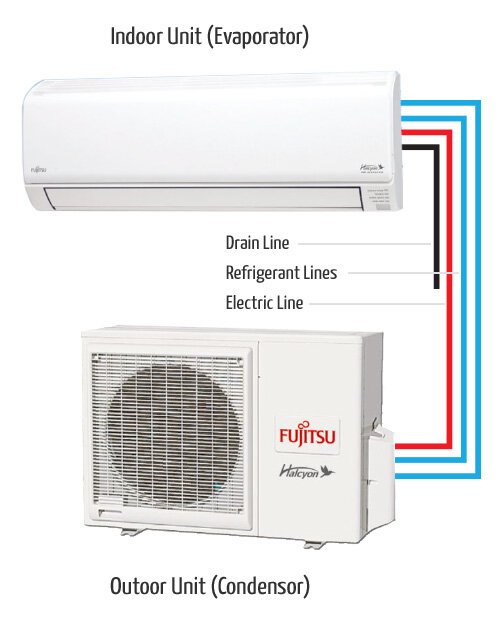Air conditioning and Solar Power | Most efficient A/C units
Before adding a solar system, the first thing you should do is look at how you can reduce your electricity consumption (electricity is typically measured in kilowatt hours (kWh), see the explainer here). By reducing your consumption you will decrease the size of a solar system required for your home. The first area of consideration is the air conditioning (A/C), as it is typically the biggest user of energy.
According to shrinkthatfootprint.com, the top three countries in the world for energy consumption, by household, are Canada (32.5 kWh), USA (32 kWh) and Australia (19.8 kWh). These are national averages, and take into consideration apartments and townhouses/condominiums. Generally speaking, this will be higher for single family detached homes. However, the single largest electrical energy consumer in the home is the A/C unit.
A/C Unit Comparison
A/C units fall into three broad categories:
Central or whole home (ducted)
Window or wall inserted units (self contained)
Two stage split units (with an inside primary unit and the compressor outside the home)
The central unit is one large exterior unit, that is piped or ducted to distribute the cool (or warm) air throughout the home to the individual rooms.
Window or wall units are designed to fit in a window space and have both the compressor and the distribution unit combined. These units are designed to cool (or warm) defined, enclosed spaces such as bedrooms.
Two stage, split units are a combination of the central type of unit (with a separate exterior compressor and an interior distribution or head unit, mounted on a wall). These units, like the window type are designed to cool (or warm) defined, enclosed spaces like bedrooms.
Two stage split unit
Each of these units have advantages and disadvantages for homeowners, when it comes to their functions and cost of use. The concern is, how to reduce the cost of use. In other words, how to use them more efficiently and thereby lessen the load on either the power grid or the solar system. Fewer kWh = a smaller solar system and/or a lower electric bill (and carbon emissions).
Homeowners can make a substantive difference in the size of the solar system they require by making a few key changes to the type of A/C used and how it is used. These changes may (in some cases) reduce solar system requirements by over 50%. A 20 – 30% system reduction is normal.
A/C Unit Efficiency
A discussion of central A/C units vs other types, is out of scope of this article, there are just too many options to review and compare. However, the changes in usage patterns generally remain valid across all types of A/C units.
Window units are the least expensive and the easiest to install (generally no A/C installer needed). However, they are by far the least efficient. These units, where possible, should always be replaced with high efficiency models.
Two stage split units come in many sizes and have three basic configurations:
Non-inverter or standard
Single stage inverter and
Dual stage inverter
The efficiency differences between these three are substantial. When installed and used properly, the inverter and dual inverter can save a homeowner thousands of kWh per year, over the non-inverter type of A/C. The key is in understanding the per hour rate of power consumption of any A/C unit vs the per day average production for a solar system.
It is simple; an inefficient standard A/C unit will use as much as 4 times the power of a comparably sized dual inverter A/C unit. The real kicker is (in many countries) the cost of a dual inverter A/C unit can be less than the cost of 2 or even 3 solar panels installed on your home. This means you can either run your A/C longer with the same number of panels, or you can install a smaller solar system. Sometimes much smaller. Conserving power with the high efficiency A/C units becomes even more important in areas that have variable tariffs for power consumption based on time of day. In these cases you are most likely running the A/C units at the peak tariff time, while the solar system is producing power at the lower tariff times of the day.
You may even qualify for government rebates on the new A/C units. To see if this is the case, follow these links:
Australia - https://www.energy.gov.au/rebates
USA - https://www.energystar.gov/rebate-finder
Canada - https://www.canada.ca/en/environment-climate-change/news/2019/08/energy-savings-rebate-program.html, https://www.furnaceprices.ca/furnace-air-conditioner-rebates/
For readers not in these countries, check your government websites for similar rebate programs. Many countries are making rebates available for energy efficient upgrades.
In some cases, the rebates available for energy efficient upgrades, can be greater than the rebates for installation of solar systems. The bottom line is to do the research, in your area, to create the most energy efficient home possible, for the budget available.
Usage patterns to reduce A/C running costs
A/C units are designed to cool a home or a room but they have limits. The hotter it is outside and the cooler you want the room, the harder the unit needs to work, to achieve the temperature you desire. Generally the A/C units, should be set to a maximum of 5 degrees below the outside temperature. Lower than this and the unit will either work much harder to get to temperature and remain there or, it will work at maximum, continuously trying to get to the desired temperature. For example: If the outside temperature during the day is a high of 31, you will get the best results by setting the A/C unit between 26 and 28. Below 26 and the unit will waste energy trying to keep the room or home cool. The closer to the high temperature you can set the A/C unit, the less energy it will consume to get the room to that temperature and maintain it. Try setting your A/C to a minimum of 24 degrees in summer, and a max of 20 in winter. Here is a trick to work your way toward a higher A/C setting. Adjusting the A/C to one degree higher each week or two, will allow you to acclimate to the new higher setting far more easily than increasing the setting from 22 to 27 from one day to the next.
There are many things that can be done with the building envelope. Caulking doors and windows to prevent hot air from entering, is an inexpensive way to reduce A/C use. As well, installation of door sweeps and/or the use of door snakes (sewn tubes of cloth filled with batting) at the bottom of the door, will stop the loss of cold air under the doors to the outside and they can be used on inside doors, when cooling a bedroom or other room.
Zone cooling your home. When using any type of A/C, you can practise zone cooling. Only cool the room(s) you are using. Leave unoccupied rooms uncooled. As well, when cooling a room – close the door (seems obvious but some people….) Another trick, is to turn off the A/C in the room you are in, about an hour before retiring. Then turn the bedroom A/C on, within the parameters listed above. Over the next hour the room you are in will warm up and so will you, but not to the point that you will really notice. However, head to bed and it will feel cool and comfortable.
With today’s technology, it is possible to set the A/C on timers or to use your phone to control your A/C. This allows you to turn off the A/C when you leave the home and have it timed or turn it back on remotely, so the home is pre-cooled when you arrive. You can also do this while the sun is still out and take advantage of the solar panels providing the power.
Turning your thermostat down a few degrees will reduce your energy consumption considerably - Image credit Guardian
A final point, or two. Ceiling fans used in conjunction with A/C. You should not use ceiling fans when the A/C is in operation. A/C units are designed to blow cool air down into the room, forcing the hot air to rise more rapidly and be captured and expelled by the A/C unit. A ceiling fan interrupts this natural air flow, by blowing the warm air back down to mix with the cool air. This keeps the room warmer and the A/C working longer and harder. Instead use a personal fan blowing horizontally. These will blow the cool air over you directly and use far less energy than a ceiling fan.
Use the dehumidify or the raindrop setting on the remote unit. If you are in the tropical region or on the coast, this setting is a must have. This setting will recirculate the air in your home and remove the moisture. It uses less power to do this than it does to cool the room, however, the room will feel about 5 degrees cooler.
Combining the use of energy efficient equipment with changes in use patterns and simple modifications to your home, will substantially lower the power you consume. This will have a beneficial effect on your pocketbook, lower the size of the solar system you require and be beneficial for the planet. All win-win situations.
Tony Hugh is CEO of Emerald Coast Solar, Yucatan Mexico



